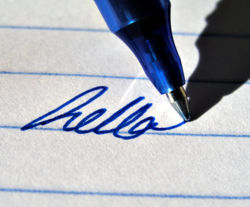Rollerball pen: Difference between revisions
No edit summary |
|||
| Line 46: | Line 46: | ||
*[http://www.wima.org/directory/index.htm Writing Instrument Manufacturers Association] |
*[http://www.wima.org/directory/index.htm Writing Instrument Manufacturers Association] |
||
* [http://www.parkercollector.com '''Parkercollector.com'''] (Detailed information about most models made by the Parker Pen Company.) |
|||
[[Category:Pens]] |
[[Category:Pens]] |
||
Revision as of 22:51, 26 July 2009

Rollerball pens are writing instruments which use ball point writing mechanisms with water-based liquid or gelled ink, as opposed to the oil-based viscous inks found in ballpoint pens. The characteristics of these less viscous inks, which tend to saturate more deeply and more widely into paper than other types of ink, give rollerball pens their distinctive writing qualities.

The rollerball pen was initially designed to combine the convenience of a ballpoint pen with the smooth "wet ink" effect of a fountain pen. Gels usually contain pigments, while liquid inks are limited to dyestuffs, as pigments will sink down in liquid ink (sedimentation). It is the thickness and suspending power of gels that allows the use of pigments in gelled ink. Using pigments (the same pigments that are used in paint) yields a greater variety of brighter colors than is possible in liquid ink. Gels also allow for the use of heavier pigments with metallic or glitter effects, or opaque pastel pigments that can be seen on dark surfaces.
Writing with liquid ink pens cannot be seen on dark surfaces because inks containing dyes need a light colored, reflective background, because dyes do not reflect light by themselves, in the way that pigment particles do. Dye molecules absorb all but a particular wavelength of light, so light must pass through the ink and bounce off a reflective background in order for our eyes to see the color of the ink.[citation needed]
Advantages over ballpoint
A rollerball pen has three main advantages over a ballpoint pen:
- Less pressure needs to be applied to the pen to have it write cleanly. This permits holding the pen with less stress on the hand, saving energy and improving comfort.
- The inks usually have a greater range of colors due to the wider choice of suitable water-soluble dyes and/or to the use of pigments.
- They usually tend to write more boldly and clearly than ballpoint pens do.
Disadvantages

There are a number of disadvantages inherent to rollerball pens:
- Water-based rollerball ink is more likely to smudge than a ballpoint pen's oil-based ink because water-based ink dries more slowly. Also if one writes in a notebook, closing it before the ink dries can stain the opposite page. Gel ink dries much more rapidly than liquid-ink, making it much more, but not completely, resistant to smudging.
- Rollerballs with liquid-ink much more frequently "bleed" through the paper. Liquid ink is more readily absorbed into the paper due to its lower viscosity. This viscosity also causes problems when leaving the tip on the paper (to pause for a thought for example [citation needed]); the bleed-through effect is greatly increased as the ink is continually absorbed into the paper, creating a blotch. None of these things affect gel-ink rollerballs nearly as much. This is one way through which the thickness of gel-ink gives it an advantage, in that it isn't as prone to being absorbed. Though the bleed-through effect of a gel-ink rollerball is greater than that of a ballpoint, it is usually not too significant.
- A disadvantage of gel ink is that its greater viscosity increases the likelihood of intermittent (as opposed to consistent) inking of the ball, producing "skipping" where the flow of ink randomly ceases. The amount of skipping varies widely with the pen. Conversely, liquid-ink rollerballs flow extremely consistently, and skip less than ballpoints do.
- Rollerball pens generally run out of ink more quickly than ballpoints because rollerballs use a greater amount of ink while writing. This is especially true of liquid-ink rollerballs, due to gel ink having a low absorption rate as a result of its thickness. Neither lasts as long as a ballpoint.
- Uncapped rollerball pens are more likely to leak ink when, for example, placed into a shirt pocket, but this is easily avoided by recapping the pen.
- A rollerball tip is more likely to clog and jam when writing over correction fluid that has not yet completely dried. This often renders the ink cartridge useless.
Additional uses
Former MI-6 agent Richard Tomlinson alleges that Pentel Rolling Writer rollerball pens were extensively used by SIS agents to produce secret writing (invisible messages) while on missions.[1]
References
- ^ Tomlinson, Richard: The Big Breach: From Top Secret to Maximum Security, pg 44. Mainstream Publishing 2001 ISBN 1-903813-01-8
See also
External links
- Writing Instrument Manufacturers Association
- Parkercollector.com (Detailed information about most models made by the Parker Pen Company.)
